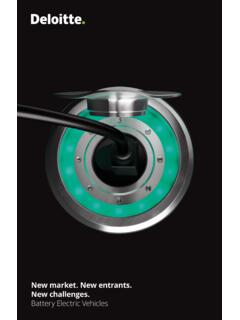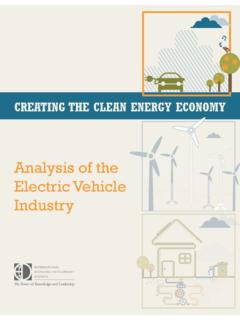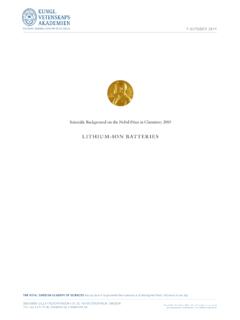Transcription of RECYCLING OF LITHIUM- ION BATTERIES
1 RECYCLING OF LITHIUM- ION BATTERIES Fundamentals Structureandfunction ofLIB Cost overview Cathodecomposition Anode composition LifeCycleAssessment(LCA) Sustainability LIBrecycling HandlingEoLbatteries Risksin handlingwithLIB Transportandstorage CharacterizationofLIB LIBclassification Disassembly challenges Openingofthe housing Disassemblyofthebatterypack Disassemblyofthebatterymodules Automation oftheprocess RECYCLING Overview Mechanical RECYCLING Pyrometallurgy HydrometallurgyOverview LITHIUM- ion battery (LIB) Theamountoflithium-ionbatteries(LIBs)in their"endoflife"(EoL) willincreasesignificantly inthecomingyearsdueto thegrowingmarketpenetrationofelectric vehicles,whichis why newconceptsforrecyclingandrawmaterialrec overy mustbe developed. Theprocessscrapgeneratedinbatteryproduct ionwillensurea needforhigherrecycling capacities inthenear future. To implementsustainableEoLconcepts, allplayersalongthevaluechainfrom materialsynthesisto batterycell,batterymodule,andbatterypack productionto theusephasemustaddressthisissue.
2 Recyclingrates forindividual materials(upto95%)are proposedbytheCEID(CircularEconomyInitiat iveGermany,acatech)* andalsoenvisaged bytheEUin with EoL-BatRecycling*Circular Economy Initiative Germany (ed.): Battery Life Cycles. Driving electric Mobility with the Circular Economy, *Kwade, A., Hagel ken, C.,et al, acatech/SYSTEMIQ, Munich/London 2020. Thebatterypackconsists of severalbatterymodulesandotherelectrical, mechanical,andthermalcomponents. It isconnectedanddimensioneddifferentlydepe ndingontherequiredperformancedata. Thebatterymodule in turnconsists ofbatterycellsthatcanbeconnectedinseries orparallel. Thebatterycell existsinthreedifferentcellformats: cylindrical cells,prismatic cellsandpouchcells. Thegeneralstructureofthe batterycellisindependentoftherespectivec elltype. Ingeneral,a batterycellconsists ofanodes andcathodes aswellastheseparator, whichseparatestheelectrodesfromeachother . Betweenthemtheion-conductingelectrolyte necessary forchargetransportis located.
3 Theuseofhigh-grademetalsastheactive materialofthecathode makesitakeycomponentinthefieldofrecyclin gandit is thereforeexaminedinmoredetail below. Thecathode consists ofa currentconductor(oftenaluminumfoil)andth eactive material, whichoftenhas oneofthefollowingcompositions: NMC(lithiumnickelmanganesecobaltoxide), LCO (lithiumcobaltoxide), LM(N)O (lithiummanganese(nickel)oxide), LFP(lithiumironphosphate), NCA(lithiumnickel cobaltaluminumoxide)Structure and function of LIB Fundamentals Battery module Battery cellsBattery pack Battery modulesKampker et al. "Assembly process of a battery module and pack," et al. "Production process of a LITHIUM- ion battery," cellsInsulation plateInsulation foilBMS slave and contacting systemSensorsBattery cellsModulehousingBattery modulesHigh-voltage moduleService plugand power connectionCooling systemBMS MasterCoolant connectionWiringCAN interfaceDisassemblyRecyclingDealing with EoL-Bat* Metastudy from the following sources: Kampker et al.
4 "Component production of a LITHIUM- ion battery cell," 2019; Friedrich et al. "Recovery of Valuable Metals from E-Waste and BATTERIES by Smart Process Design," RWTH Aachen, IME, 2019; Kwade, A., Haselrieder, W., Leithoff, R. et al. "Current status and challenges for automotive battery production technologies," Nat Energy 3, 290-300 (2018).CostoverviewFundamentals Themostexpensivecomponent ofa batteryelectric vehicle(BEV)is thebatterypack, accountingforupto50% ofthe totalcost. Materialcostsaccount forthemainshareoftotal batterycostsinthemanufactureoflithium-io nbatterycells. Thecathodematerial is themostexpensivecomponentofthe batterycell,accountingfor about44 % ofthematerial costs. Byusinghigh-qualitycathodeandanodemateri als, thereis a possibilityofmakingthe batterymorepowerful,moreenergetic, and thusmore assertive. Fortherecoveryofthehigh-gradecathode materials,nocontinuouseconomicrecyclingp rocesscurrentlyexists industrially,and no industrialrecyclingsolutionexistsforthea nodematerials.
5 Materialsfromthebatterysystemsuchassteel andplastics are alreadysuccessfully separated fromtheremaining componentsbymechanicalseparation processes(viadensity,particle size, magnetizability,etc.), which iswhythesematerialsarenotdiscussedin detailhere. Therawmaterialslithium,cobalt,nickel andmanganese areprimarilythefocusofcurrent and futurerecyclingprocesses,eventhoughtheyo nlyaccountforlessthanonethirdoftheweight ofthematerial composition oftheentirebatterysystem. In thecourse oftheoverallrecyclingratesofuptomorethan 70%tobeachieved, : 72%Manufacturing: 19%Other: 9%Batterytotal cost* Cathode: 44%Separator: 17%Anode: 15%Other: 5%Batterymaterial costs*Electrolyte: 10%Housing: 9%DisassemblyRecyclingDealing with EoL-BatCathode compositionFundamentals Thegraphshowsthemassfractionsofthefourma incathodeactivematerials in relationto thecollectedusedbatteriesin 2020. InadditiontoNMC111 ,othervariations ofNMCareusedinBEV whichhavea highernickelcontent.
6 UnlikeNMC,LCOandLMOconsist ofonlyoneofthe threemetals; LFPcontainsiron. This resultsindifferentproperties in termsofenergydensity,service life, andsafety. LMOformsdifferentoxides (e . ,Li2 MnO3), sothatonlyanaveragevalueoverallmass fractionscanbepresentedhere. The highlyfluctuatingrawmaterialpricesofthes eelements arecausingbatterycellmanufacturerstostri vefor rawmaterial security,which canbeachievedthrough newrecyclingtechnologies, amongotherthings. Thesefluctuationsalsoarisedueto thelongsupplychains, as rawmaterialdeposits costs Currently, companies that put BATTERIES on the market have to plan for high disposal costs and build up appropriate used BATTERIES collected, as of 2020*. NMC: 3,700 tons LCO: 2,700 tons LMO: 1,500 tons LFP: 250 tons* Friedrich et al. "Recovery of Valuable Metals from E-Waste and BATTERIES by Smart Process Design," RWTH Aachen University, IME, et al. "The case for RECYCLING : Overview and challenges in the material supply chain for automotive li-ion BATTERIES ," Oxygen:33,2%Cobalt:20,3%Nickel:20,3%Mang anese:19%Lithium:7,2%LiCoO2 LCOC obalt:60,2%Oxygen:32,7%Lithium:7,1%LMO Manganese:55,2%Oxygen:35,6%Lithium:9,2%L ixMnyOzDisassemblyRecyclingDealing with EoL-BatLiNixCoyAl1-x-yO2 Nickel:47,7%Oxygen:33,2%Cobalt:8,9%Lithi um:7,2%Aluminum:3%NCA LiNixMnyCo1-x-yO2 Anode compositionFundamentals Chae et al.
7 "Integration of Graphite and Silicon Anodes for the Commercialization of High-Energy LITHIUM- Ion BATTERIES ," UNIST, Korea, *SiC6/SiC6 Graphite:100%SiDisassemblyDealing with EoL-BatRecycling Thegraphshowsthemassfractionsofthefourmo stimportantanodeactivematerials in relationto the stateoftheartandresearch. However,withregardto thecollectedend-of-lifebatteriesin 2020, onlythegraphiteanode is relevant. The mixtureofgraphiteandsilicon increasestheenergydensityandthefast-char gingcapability,amongotherthings. In thelongterm,theaim istousepuresilicontomaximizeenergydensit y, amongotherthings. Inaddition,anodesmadeoflithiummetalarebe ingdevelopedwhichhaveveryhighenergydensi tiesbutbring withthem thechallengeofdendriteformation. challenges inusing puresiliconanodesincludeagglomeration ofli-ions,formation oftheSEIlayer,anddendriteformation. If lithium isembeddedin thesiliconduring the chargingprocess,this resultsin a largevolumechange in theanode.
8 Toavoid damagetotheanode,theamountofsiliconadded is crucial. Topreventthesiliconanode frombeingdamaged,it canbecoatedwithsiliconoxide (SiOx). Sincetheuse ofSiOxproducesundesirableirreversibleby- productssuchasLi2 OandLi4 SiO4, thelong-termaim istouse puresilicon. Sofar, ,therecoveryofgraphite is steadily gaining inimportance. Throughtherecyclingofgraphite,it canbeextractedorproducedinEurope, :>89%Silicon:<11%Silicon:100%LiLiLithium :100%Use Despitethehighcost ofthe battery especiallydueto theexpensiverawmaterials theenvironmentalaspect shouldbeconsideredintensively. Atthebeginningoftheir lifecycle, BEVshavea largerCO2footprintthaninternalcombustion enginevehicles(ICEVs)buta lowerCO2impact intheusephase. ThelargeinitialCO2footprintresultsfrompr imarymaterialprocessing andbatterycellproduction. Thevariability ofenvironmentalimpactsduringtheusephase ofBEVsdependson various ,thispointis usuallyreachedafter50,000to80,000kilomet ersdriven.
9 Factorsinfluencingthebreak-evenpoint includetheenergymixusedduring charging,climateconditionsduring use(season/time ofday),topology, oruserbehavior. Anenergymix withahighershareofgreenelectricitypositi vely influencesthebreak-evenpoint. In general,factorsthatextend batterylife canpositively influencetheoverallbalance. Therecyclingtechnology especiallyforthe batterycells alsoexertsamajorinfluenceontheoverallenv ironmentalimpactofa BEVandcanaffectthelife cycleassessmentpositivelyinparticular,bu talso negativelyinunfavorable cases. Anearlybreak-evenpoint andeffectiverecyclingtechnology mustbeachievedsothate- [kg CO2eq .]Mileage [km]RecyclingBreak-even pointBatteryMaterial & ProductionBattery cells 40-50%Material supply& ProductionLife Cycle Assessment (LCA)Fundamentals DisassemblyRecyclingRegett et al. "Climate footprint of electric vehicles," 2018 l Agora Verkehrswende "Climate footprint of electric cars ," 2019 Acatech et al.
10 "Resource-efficient battery cycles," 2020 l Ciez et al. "Examining different RECYCLING processes," 2019 Dealing with EoL-Bat Inadditionto thefactorsmentionedbefore,thebreak-evenp ointalsodependsontheenvironmentalbalance ofbatterymaterialproduction. At< (exceptforMn),thematerialsareonly slightlypresentin the earth'scrustandare alsonotmined inGermany. Theminingofthelightmetallithiumrequiresv erylargequantitiesofwater,whichresults infallinggroundwaterlevelsinthesalt lakes intheminingareas. Thewaterdepletionhasa negativeimpactonthelocalagricultureand thusonthebasicsupplyofthepopulation. Inaddition,the extractionofthesemetalsthroughrefiningpr ocessessignificantly pollutestheenvironment. Quantitative statementsabouttheexactproportion aredifficulttomakeduetoa lackof information. Theunevendistributionofrawmaterials acrossdifferentcontinentsresultsin longtransport routes,whichare associatedwith highCO2emissions. Forthisreason, too,thefurtherdevelopmentofrecyclingtech nologytorealizea localcirculareconomycontinuestogain A circular economy can greatly reduce CO2emissions generated by mining, refining and transporting raw CO2emissions in 2019 for the production ofNMC BATTERIES for small cars were around 70-77 kg/kWh of battery capacity*.






